Related Research Articles

Accordions are a family of box-shaped musical instruments of the bellows-driven free reed aerophone type. The essential characteristic of the accordion is to combine in one instrument a melody section, also called the diskant, usually on the right-hand keyboard, with an accompaniment or Basso continuo functionality on the left-hand. The musician normally plays the melody on buttons or keys on the right-hand side, and the accompaniment on bass or pre-set chord buttons on the left-hand side. A person who plays the accordion is called an accordionist.
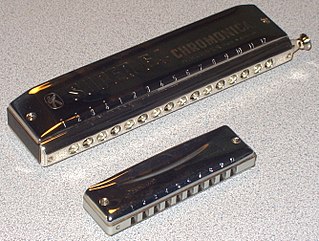
The harmonica, also known as a French harp or mouth organ, is a free reed wind instrument used worldwide in many musical genres, notably in blues, American folk music, classical music, jazz, country, and rock. The many types of harmonica include diatonic, chromatic, tremolo, octave, orchestral, and bass versions. A harmonica is played by using the mouth to direct air into or out of one holes along a mouthpiece. Behind each hole is a chamber containing at least one reed. The most common is the diatonic Richter-tuned with ten air passages and twenty reeds, often called the blues harp. A harmonica reed is a flat, elongated spring typically made of brass, stainless steel, or bronze, which is secured at one end over a slot that serves as an airway. When the free end is made to vibrate by the player's air, it alternately blocks and unblocks the airway to produce sound.

The sheng is a Chinese mouth-blown polyphonic free reed instrument consisting of vertical pipes.
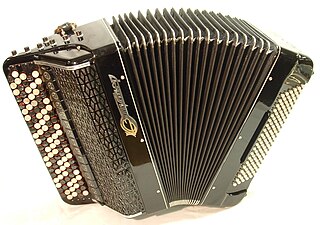
The bayan is a type of chromatic button accordion developed in the Russian Empire in the early 20th century and named after the 11th-century bard Boyan.

A Chemnitzer concertina is a musical instrument of the hand-held bellows-driven free-reed category, sometimes called squeezeboxes. The Chemnitzer concertina is most closely related to the bandoneón, and more distantly, to the other types of concertinas and accordions. It's essentially a bigger version of the Anglo Concertina that sounds more akin to an Accordion due to having Multiple Ranks of Reeds.

The garmon, commonly called garmoshka, is a kind of Russian button accordion, a free-reed wind instrument. A garmon has two rows of buttons on the right side, which play the notes of a diatonic scale, and at least two rows of buttons on the left side, which play the primary chords in the key of the instrument as well as its relative harmonic minor key. Many instruments have additional right-hand buttons with useful accidental notes, additional left-hand chords for playing in related keys, and a row of free-bass buttons, to facilitate playing of bass melodies.
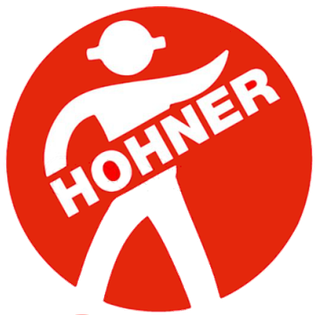
Hohner Musikinstrumente GmbH & Co. KG is a German manufacturer of musical instruments, founded in 1857 by Matthias Hohner (1833–1902). It is a subsidiary of Matth. Hohner AG. The roots of the Hohner firm are in Trossingen, Baden-Württemberg. Hohner has manufactured a wide range of instruments, such as harmonicas, kazoos, accordions, recorder flutes, melodicas, banjos, electric, acoustic, resonator and classical guitars, basses, mandolins and ukuleles. Hohner is known mostly for its harmonicas.

The Richter-tuned harmonica, 10-hole harmonica or blues harp, is the most widely known type of harmonica. It is a variety of diatonic harmonica, with ten holes which offer the player 19 notes in a three-octave range.
There are numerous techniques available for playing the harmonica, including bending, overbending, and tongue blocking.

A button accordion is a type of accordion on which the melody-side keyboard consists of a series of buttons. This differs from the piano accordion, which has piano-style keys. Erich von Hornbostel and Curt Sachs categorize it as a free reed aerophone in their classification of instruments, published in 1914. The sound from the instrument is produced by the vibration of air in reeds. Button accordions of various types are particularly common in European countries and countries where European people settled. The button accordion is often confused with the concertina; the button accordion's buttons are on the front of the instrument, where as the concertina's are on the sides and pushed in parallel with the bellows.

Chord organ is a kind of home organ that has a single short keyboard and a set of chord buttons, enabling the musician to play a melody or lead with one hand and accompanying chords with the other, like the accordion with a set of chord buttons which was originated from a patent by Cyrill Demian in 1829, etc.

The Flutina is an early precursor to the diatonic button accordion, having one or two rows of treble buttons, which are configured to have the tonic of the scale, on the "draw" of the bellows. There is usually no bass keyboard: the left hand operates an air valve. A rocker switch, called a "bascule d'harmonie" is in the front of the keyboard. When this switch is thumb activated, it would open up a pallet (a pad that covers a tone hole, at the other end of the key button, for a simple Tonic/Dominant drone: Tonic on the draw and Dominant on the press, e.g. Tonic notes C/g, and Dominant G/d, without any major or minor thirds.

A melodeon or diatonic button accordion is a member of the free-reed aerophone family of musical instruments. It is a type of button accordion on which the melody-side keyboard contains one or more rows of buttons, with each row producing the notes of a single diatonic scale. The buttons on the bass-side keyboard are most commonly arranged in pairs, with one button of a pair sounding the fundamental of a chord and the other the corresponding major triad.
The chromatic harmonica is a type of harmonica that uses a button-activated sliding bar to redirect air from the hole in the mouthpiece to the selected reed-plate desired. When the button is not pressed, an altered diatonic major scale of the key of the harmonica is available, while depressing the button accesses the same scale a semitone higher in each hole. Thus, the instrument is capable of playing the 12 notes of the Western chromatic scale. The chromatic harmonica can thus be contrasted with a standard harmonica, which can play only the notes in a given musical key.

A tremolo harmonica is a type of diatonic harmonica, distinct by having two reeds per note. In a tremolo harmonica, the two reeds are tuned slightly off a reference pitch, one slightly sharp and the other slightly flat. This gives a unique wavering or warbling sound created by the two reeds being not exactly in tune with each other and difference in their subsequent waveforms acting against one another. The degree of beating can be varied depending on the desired effect. Instruments where the beating is faster due to the reeds being farther apart from the reference pitch are called "wet", whereas those where the beating is slower and less noticeable due to the reeds being more closely in tune are called "dry".
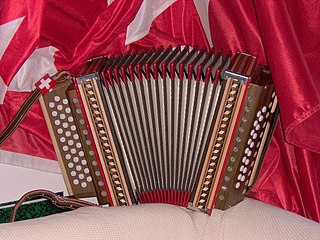
The Schwyzerörgeli is a type of diatonic button accordion used in Swiss folk music. The name derives from the town/canton of Schwyz where it was developed. Örgeli is the diminutive form of the word Orgel (organ). Outside of Switzerland the instrument is not well known and is hard to find.
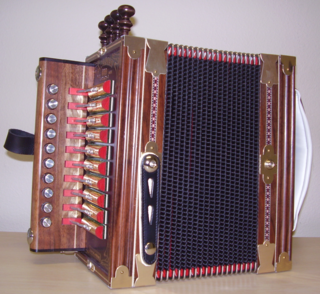
A Cajun accordion, also known as a squeezebox, is single-row diatonic button accordion used for playing Cajun and Creole music.
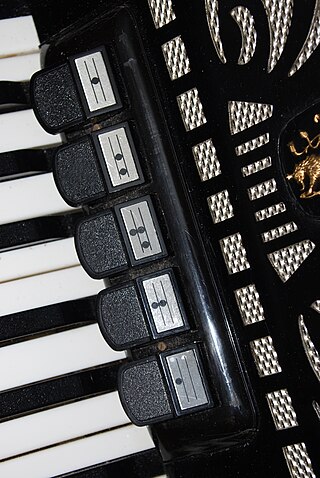
A reed rank inside an accordion is a single full set of the reeds that are the means to achieve the instrument's sound range. These reed ranks are located in the reed chamber. Most accordions to this date typically have between two and four reed ranks on the treble side and between three and five reed ranks on the bass side. These can usually be selected individually or combined in various ways to provide a range of different timbres, by use of register switches arranged by register from high to low. More of the top-line expensive accordions may contain five or six reed blocks on the treble side for different tunings, typically found in accordions that stress musette sounds.

The Steirische Harmonika is a type of bisonoric diatonic button accordion important to the alpine folk music of Croatia, Slovenia, the Czech Republic, Austria, the German state of Bavaria, and the Italian South Tyrol. The Steirische Harmonika is distinguished from other diatonic button accordions by its typically richer bass notes, and by the presence of one key per scale row that has the same tone on both compression and expansion of the bellows, called a Gleichton. The bass notes earn the distinction Helikonbässe because they use bigger reeds with duralumin reed frames and a special chamber construction that amplifies its bass tones to give it a loud sound reminiscent of a Helicon tuba.

Khromka is a type of Russian garmon. It is the most widespread variant in Russia and in the former USSR. Nearly all Russian garmons made since the mid of the 20th century are khromkas.
References
- Gotthard Richter: Akustische Probleme bei Akkordeons und Mundharmonikas, Tl.1, Einführung in die allgemeinen Grundlagen. ISBN 3-925572-00-7
- Gotthard Richter: Akustische Probleme bei Akkordeons und Mundharmonikas, Tl.2, Untersuchungen spezieller Phänomene. ISBN 3-925572-01-5
- Gotthard Richter: Akkordeon. Handbuch für Musiker und Instrumentenbauer. 3. Auflage 2003, ISBN 3-7959-0569-9